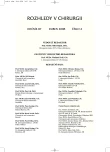Incidence and Management of Prolonged Air Leak Following Pulmonary Lobectomy
Authors:
J. Šafránek
; J. Vodička; V. Špidlen; J. Klečka; V. Šimánek; K. Houdek
Authors‘ workplace:
Chirurgická klinika FN Plzeň, přednosta: prof. MUDr. V. Třeška, DrSc.
Published in:
Rozhl. Chir., 2008, roč. 87, č. 4, s. 176-179.
Category:
Monothematic special - Original
Overview
Introduction:
Prolonged air leak (prolonged air leak – PAL, an air leak for over 7 postoperative days) is a common complication following lung resections. It extends the period of thoracic drainage, duration of hospitalization, increases postoperative morbidity rates and the cost of the treatment.
Methodology:
The retrospective study included a group of 256 subjects with lung lobectomies, performed during 2002–2007, where active thoracic drainage was introduced postoperatively. The following parametres were assessed: gender, age, preoperative FEV1/FVC values, intraoperative detection of pleural adhesions, missing interlobar fissures (due to stapler resections), presence of distinct bullae, number of removed mediastinal lymph nodes, lobectomy types (upper vs. lower), use of staplers and insufficient lung inflation of 2cm, detectable on x-ray on the day of the procedure.
Results:
PAL was recorded in 26 (10.1%) of the subjects and their thoracic drain was left in place for 8–34 days (the mean of 15.9 days). In 7 subjects, the active thoracic drainage was replaced by a passive one (on the 14.4th postoperative day, on average, the range: postoperative Day 11 to postoperative Day 22). In seven subjects, the drain’s position was changed , and in a single subject, reoperation for PAL was required. In particular, the following subjects are more likely to develop PAL: patients with FEV1/FVC of 80% (p-value = 0.0066; odds ratio = 3.494), where stapler resections of interlobar fissures are required (p-value = 0.0118; odds ratio = 3.070) and males (p-value = 0.0471; odds ratio = 3.200).
Conclusion:
In patients, predisposed to develop PAL, saving techniques to optimalize surgical procedures, as well as approaches to optimalize their postoperative care, including early replacement of the active thoracic drainage for the passive method, should be employed.
Key words:
prolonged air leak – lung lobectomy
Sources
1. Ponn, R. P. Complication of Pulmonary Resection. In: Shields, T. W., LoCicero, J., Ponn, R. P., Rusch, V. W. General Thoracic Surgery. Sixth edition, Lippincott Williams, Wilkins, 2005, 567–568, volume 1.
2. Brunelli, A., Monteverde, M., Borri, A., Salati, M., Marasco, R. D., Fianchini, A. Predictors of prolonged air leak after pulmonary lobectomy. Ann. Thorac. Surg., 2004, Apr; 77(4): 1205–1210.
3. Isowa, N., Hasegawa, S., Bando, T., Wada, H. Preoperative risk factors for prolonged air leak following lobectomy or segmentectomy for primary lung cancer. Eur. J. Cardiothorac. Surg., 2002, May; 21(5): 951.
4. Cerfolio, R. J., Bass, C. S., Pask, A. H., Katholi, C. R. Predictors and treatment of persistent air leaks. Ann. Thorac. Surg., 2002, Jun; 73(6): 1727–1730.
5. Abolhoda, A., Liu, D., Brooks, A., Burt, M. Prolonged air leak following radical upper lobectomy: an analysis of incidence and possible risk factors. Chest, 1998, Jun; 113(6): 1507–1510.
6. Stolz, A. J., Schützner, J., Lischke, R., Simonek, J., Pafko, P. Predictors of prolonged air leak following pulmonary lobectomy. Eur. J. Cardiothorac. Surg., 2005, Feb; 27(2): 334–346.
7. Venuta, F., Rendina, E. A, De Giacomo, T., Flaishman, I., Guarino, E., Ciccone, A. M., Ricci, C. Technique to reduce air leaks after pulmonary lobectomy. Eur. J. Cardiothorac. Surg., 1998, Apr; 13(4): 361–364.
8. Miller, J. I. Jr., Landreneau, R. J., Wright, C. E., Santucci, T. S., Sammons, B. H. A comparative study of buttressed versus nonbuttressed staple line in pulmonary resections. Ann. Thorac. Surg., 2001, Jan;71(1): 319–322.
9. Roberson, L. D., Netherland, D. E., Dhillon, R., Heath, B. J. Air leaks after surgical stapling in lung resection: a comparison between stapling alone and stapling with staple-line reinforcement materials in a canine model. J. Thorac. Cardiovasc. Surg., 1998, Aug; 116(2): 353–354.
10. Brunelli, A., Monteverde, M., Borri, A., Salati, M., Marasco, R. D., Al Refai, M., Fianchini, A. Comparison of water seal and suction after pulmonary lobectomy: a prospective, randomized trial. Ann. Thorac. Surg., 2004, Jun; 77(6): 1932–1937.
11. Brunelli, A., Al Refai, M., Muti, M., Sabbatini, A., Fianchini, A. Pleural tent after upper lobectomy: a prospective randomized study. Ann. Thorac. Surg., 2000, Jun; 69(6): 1722–1724.
12. Cooper, J. D. Technique to reduce air leaks after resection of emphysematous lung. Ann. Thorac. Surg., 1994; 57: 1038–1039.
13. Wain, J. C., Kaiser, L. R., Johnstone, D. W., Yang, S. C., Wright, C. D., Friedberg, J. S., Feins, R. H., Heitmiller, R. F., Mathisen, D. J., Selsyn, M. R. Trial of a novel synthetic sealant in preventing air leaks after lung resection. Ann. Thorac. Surg., 2001, May; 71(5): 1623–1628.
14. Kirschner, P. A. Provocative clamping and removal of chest tubes despite persistent air leak. Ann. Thorac. Surg., 1992, Apr; 53(4): 740–741.
15. Marshall, M. B., Deeb, M. E., Bleier, J. I., Kucharczuk, J. C., Friedberg, J. S., Kaiser, L. R., Shrager, J. B. Suction vs water seal after pulmonary resection: a randomized prospective study. Chest, 2002, Mar; 121(3): 831–835.
16. Cerfolio, R. J., Bass, C., Katholi, C. R. Prospective randomized trial compares suction versus water seal for air leaks. Ann. Thorac. Surg., 2001, May; 71(5): 1613–1617.
17. Cerfolio, R. J., Tummala, R. P., Holman, W. L., Zorn, G. L., Kirklin, J. K., McGiffin, D. C., Naftel, D. C., Pacifico, A. D. A prospective algorithm for the management of air leaks after pulmonary resection. Ann. Thorac. Surg., 1998, Nov; 66(5): 1726–1731.
Labels
Surgery Orthopaedics Trauma surgeryArticle was published in
Perspectives in Surgery

2008 Issue 4
- Metamizole at a Glance and in Practice – Effective Non-Opioid Analgesic for All Ages
- Metamizole vs. Tramadol in Postoperative Analgesia
- Obstacle Called Vasospasm: Which Solution Is Most Effective in Microsurgery and How to Pharmacologically Assist It?
Most read in this issue
- Patient Quality of Life Following Resection Procedures for Chronic Pancreatitis
- Experience With Ventral Hernioplasties According to Chevrel With „On-lay“ Prolene Mesh
- Chronic pancreatitis, Indications for Resection Procedures and Postoperative Complications
- Our Experience with Pancreatic Resection Procedures. Retrospective Analysis
